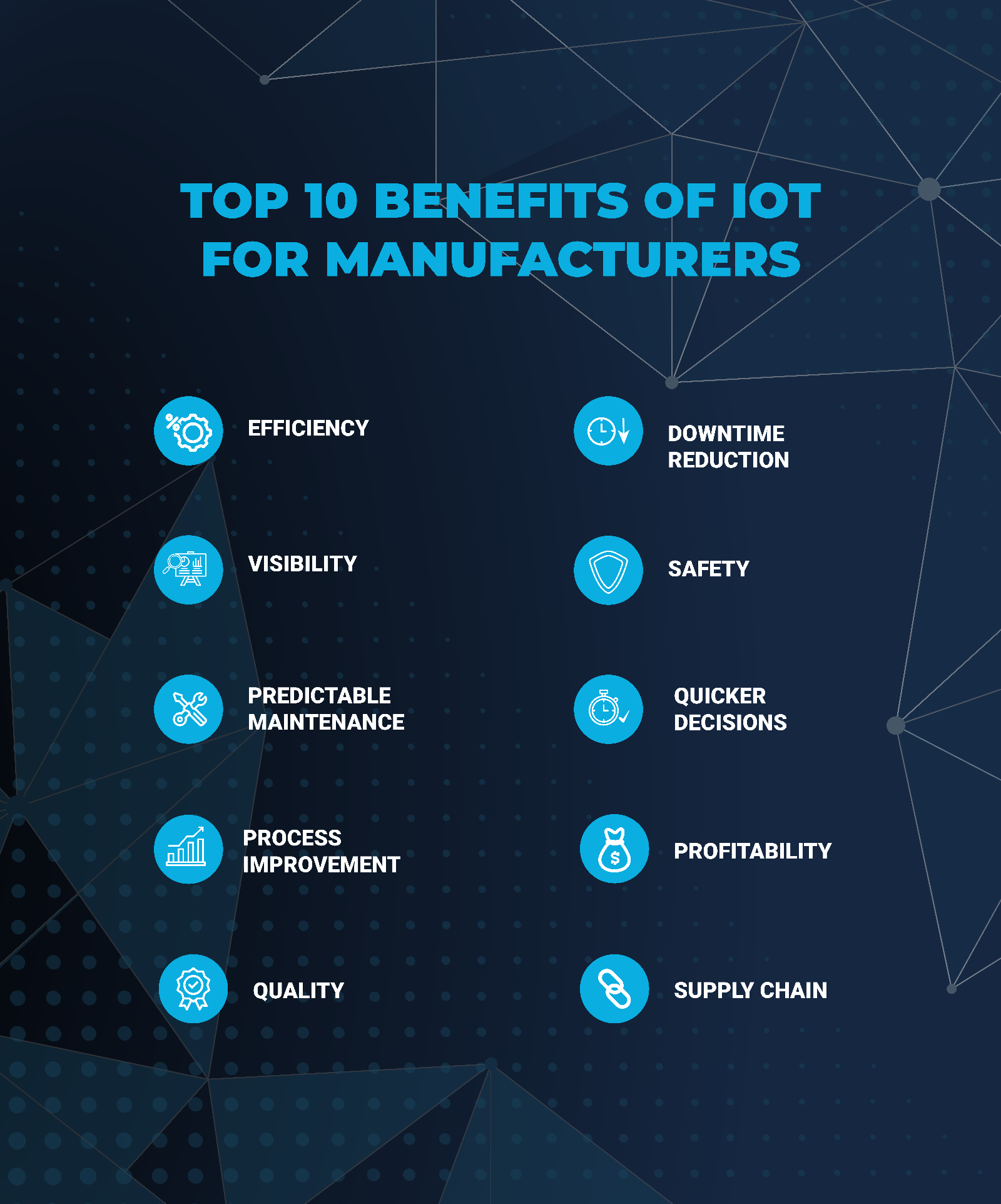Benefits of IoT
IoT in Manufacturing is on the rise in record numbers. The global IoT market will grow from $321B in 2022 to $1.69T by 2030, attaining a Compound Annual Growth Rate (CAGR) of 23.1%. IoT in manufacturing, which accounts for about a third of these numbers, has become the prelude to which many believe will be the 4th industrial revolution or as it is commonly been referred to, Industry 4.0.
Industry 4.0 refers to the concept of factories in which machines are augmented with wireless connectivity and sensors, connected to a system that can visualize the entire production line and assist manufacturers in their decision-making processes.
IoT in Manufacturing Benefits

Below, are the top 10 benefits of IoT in manufacturing:
1. Efficiency
IoT Platforms such as Freedom® AI promote optimal efficiency through real-time data to optimize asset utilization. IoT systems operate through sensors and devices which communicate to the cloud, once the data is retrieved, it can then provide better transparency to manufacturing information, with reports and analytics for optimization of machine health, process health, and OEE. Systems can also provide alerts which promote quicker decisions and adjustments to help you optimize efficiency and utilization with the ultimate goal being the improvement of your overall equipment effectiveness.
Here is an example: Before having an IoT platform such as Freedom AI, you may have had an increase in cycle times between shifts resulting in reduced part production. With the deployment of an IoT platform, you have access to real-time data that shows you exactly where the bottlenecks are happening and allows users to correct course immediately, opposed to waiting days or weeks, resulting in an immediate increase in overall productivity and efficiency.
Integrating and adopting Freedom AI’s IoT Smart Manufacturing platform, allows customers to realize documented productivity improvements of up to 50% within 12-months of deployment with a demonstrated ROI in a short period of time.
2. Visibility
Information is vital to manufacturers, suggesting when and how products are being produced. Through IoT software solutions like Freedom AI, important manufacturing data is collected and analyzed in real-time and presented as a collection of manufacturing metrics that can be accessed on any web browser from any device. This type of visibility is imperative to the success or improvement of any manufacturing process and promotes accountability through the entire facility while displaying real-time information related to key performance indicators (KPIs).
In any production process, it is easy to lose track of what is always going on in your shop but having real-time data on your production floor can help promote solutions to problems much quicker. By utilizing this type of data, you can immediately effect business model changes and evaluate operational performance factors.
3. Preventative and Predictive Maintenance
Times have changed within manufacturing maintenance. In the past, reactive maintenance has been the common practice for fixing things as they broke down. Today, thanks to Smart Manufacturing Software like the Freedom AI platform, there is now an evolution into better preventative and predictive maintenance practices. Predictive maintenance is the detection of something going wrong with a machine and the machine learning engine making predictions on appropriate corrective action items. Machine learning is a method of data analysis that automates analytical model building. It is a branch of artificial intelligence based on the idea that systems can learn from data, identify patterns and make decisions with minimal human intervention.
By incorporating real-time data into your process, major failures that used to be unforeseen and halted production can now be preempted through algorithms and can help improve overall equipment effectiveness and preventive maintenance.
Some real-world preventative examples may include: If you are working with a machine that has a wear item that fails after 500 hours of run time, you can stay ahead of a potential failure by setting an alert tied to the machine run time, and plan for and maintain the machine in an efficient and effective manner to avoid unexpected failures and unplanned maintenance. By utilizing the data and understanding frequencies and patterns, it will cause for less downtime and promote optimal performance and increased productivity.
4. Process Improvement
Improving the overall manufacturing process is an important part to the success of a company. By understanding all the manufacturing assets and performances within a plant, you have clear transparency on what performs best, what is lacking, where the bottle necks are and what is holding up your optimal output. By having this type of visibility, you can now prioritize and streamline previous processes that may have held up your production output.
5. Quality
With quality being the legacy of your company, improving your manufacturing process is imperative. By addressing holes and bottlenecks in the manufacturing process, one can improve machine performance, obtain better output and an overall improved process through speed and the quality standards of units produced and a reduced number of defective or non-conforming products.
6. Downtime Reduction
Unplanned downtime on the shop floor can be the broken cog in the process. By leveraging smart data from connected machines, you can drastically reduce downtime. This increase in operational efficiency allows for a more proactive manufacturing process that utilizes all assets to their full capabilities. You can achieve this by utilizing identifications of faulty equipment through sensor data tied to temperature gauges or vibration monitoring of pumps and motors as well as prediction of misalignment or wear items within your process. This shift from reactive maintenance to predictive maintenance can reduce breakdown by up to 90% and drastically improve your quality part count statistics. Reducing your unplanned downtime statistics will allow you to stay ahead of your production schedules and allow for increased profitability.
7. Safety
IoT in Manufacturing can help ensure a safer workplace. IoT Software platforms that communicate with the shop floor can trigger users to know when things are going wrong. This type of visibility will allow for the proper precautions to be taken and help eliminate the risks of danger. In instances, IoT also allows for connectivity through high-tech, wearable devices that employees are equipped with. Not only can this type of technology keep track of vitals and hydration levels but can also notify workers of potential collisions with heavy equipment.
8. Quicker Decisions
Before IoT, there was a lot of guess work in the manufacturing process. There wasn’t the ability to use factual data in real time. Thanks to IoT software like Freedom AI, manufacturing data collection software provides real-time collection and analysis of important manufacturing data that can be accessed on any web browser from any device. Through this, you can make real-time decisions and identify problems before they even happen. This takes the guess work out of the equation and can help improve the overall manufacturing process. One late or wrong decision can create disastrous situations and costly results. Thanks to IoT, these types of catastrophes can be greatly reduced or completely eliminated.
9. Profitability
It makes sense that by improving your manufacturing process, reducing down-time, creating visibility, improving safety measures and overall efficiency that you would expect increased profitability. But by unveiling more and more data as a result of IoT, profits and cost-reduction can be at all-time records. Aside from efficiency, improving the customer experience is another key factor. By producing higher quality and products faster you can delight the customer which promotes financial successes for your organization. To understand the potential profitability and ROI that can be recognized within IoT solutions, check out our ROI calculator, here.
10. Supply Chain
Supply chain can benefit from IoT in many ways. One of the top ways would be an improved inventory through asset tracking. In previous years, inventory has been monitored through manual tracking and hand counts, but thanks to IoT, assets can be tracked by real-time location for every piece thanks to Bluetooth tracking devices. This type of technology can notify supply chain when levels hit below a certain threshold and help maintain capacity numbers. This type of IoT technology is also helping supply chain through the logistics and transportation department as well. By improving the overall manufacturing experience, it allows for a better, faster, cheaper process and unveils performance indicators.
Closing Thoughts
IoT in Manufacturing is on the rise and will continue to evolve and revolutionize the manufacturing operations landscape. Today’s consumers increasingly demand greater customization in products. An organization’s ability to produce high-quality products and adapt to a shifting marketplace determines whether or not it can compete and succeed long-term. Advanced, digital IoT solutions like Freedom AI are helping manufacturers empower employees, create effective teams, and effectively manage change, helping manufacturers create a true smart manufacturing culture from the shop floor to the top floor.
To learn more about IoT in manufacturing or to learn ways of calculating OEE, email us at info@freedom-iot.com
2 https://www.ehstoday.com/safety-technology/6-iiot-trends-manufacturing-safety
3 https://www.grandviewresearch.com/industry-analysis/industrial-internet-of-things-iiot-market
Tags – overall equipment effectiveness, oee, overall equipment effectiveness, calculating oee, good count, key performance indicator, improve overall percentage, production time improvement, scheduled time, performance metric, manufacturing productivity , real world examples, reduced speed, productive, operation




